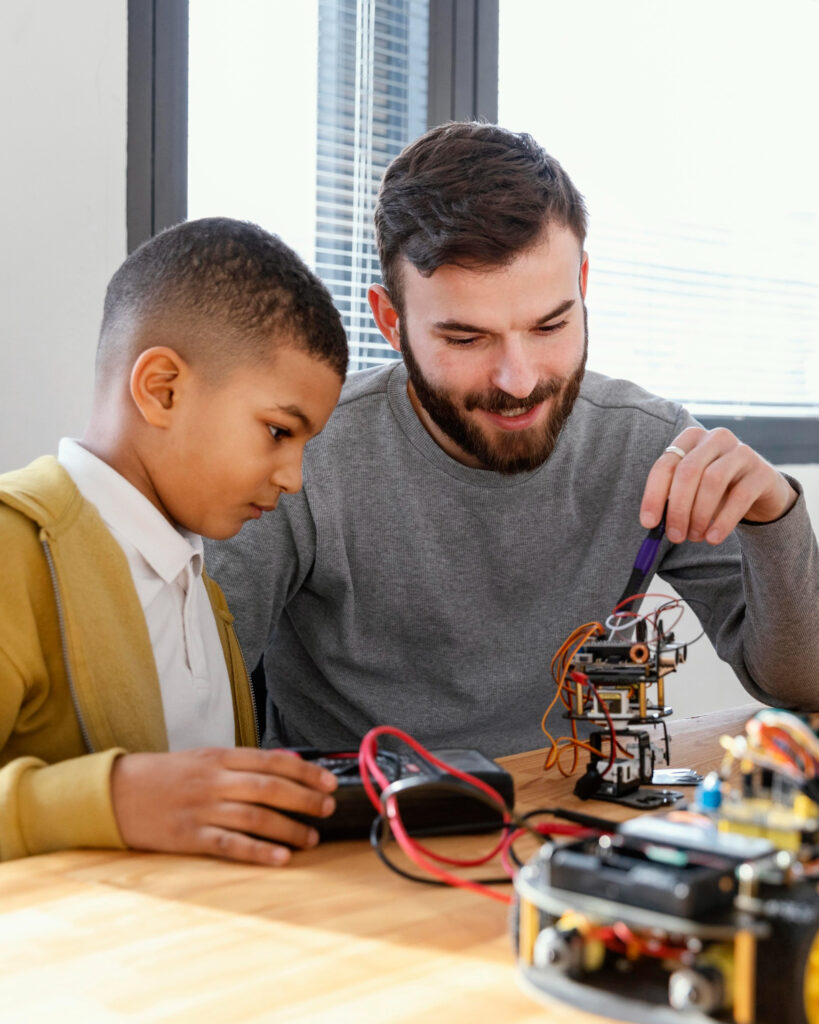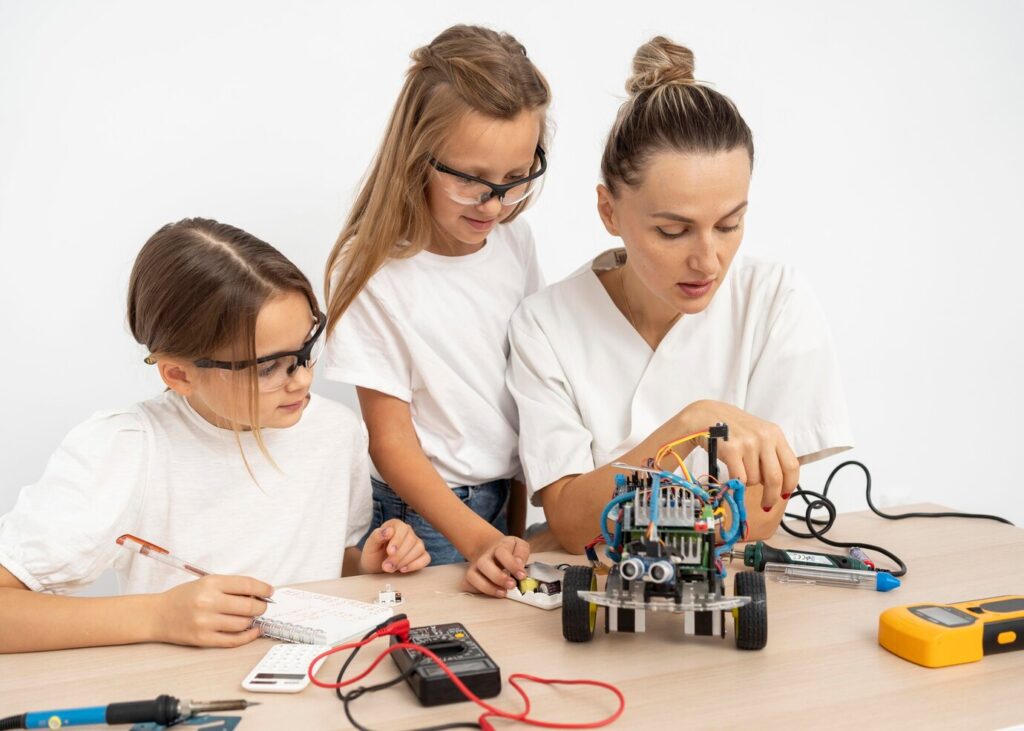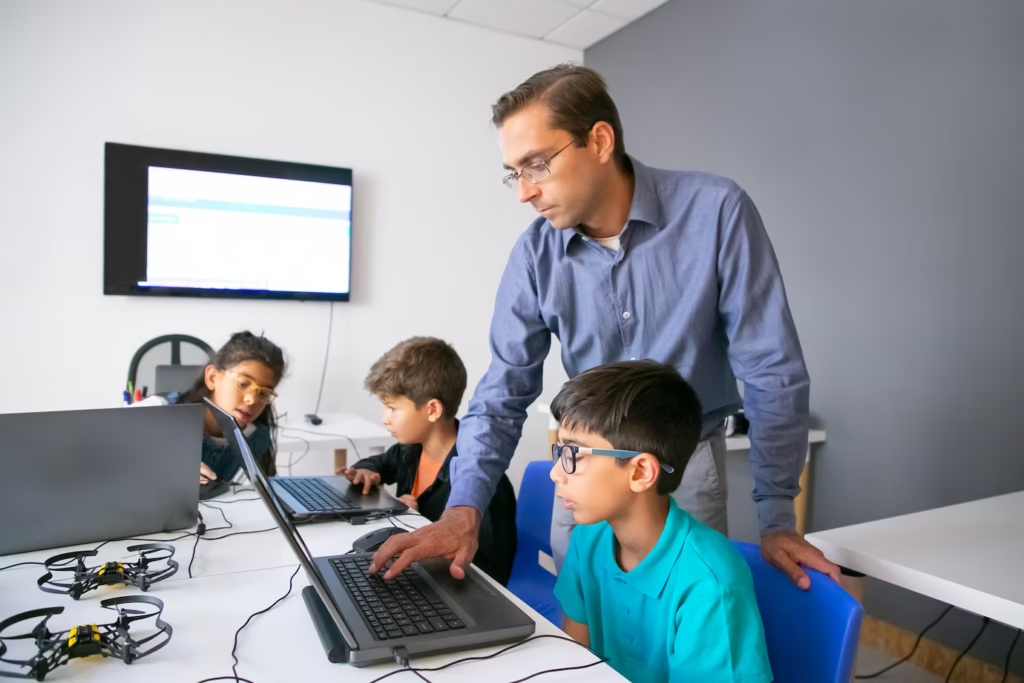Artificial Intelligence (AI) has revolutionized how we approach education, empowering teachers and students with tools that enhance learning outcomes, streamline processes, and foster innovation. In this article, we explore how AI is reshaping education, offering practical benefits and real-world applications.

Empowering Teachers with Advanced Tools
Personalized Lesson Planning
AI enables teachers to create customized lesson plans tailored to individual student needs. Tools such as AI-powered learning management systems (LMS) analyze student performance data, offering actionable insights to address strengths and weaknesses. This allows educators to optimize teaching strategies for improved engagement and retention.
Automated Grading Systems
AI-driven grading systems save teachers time and ensure objective assessment. These systems evaluate assignments, quizzes, and exams, providing instant feedback to students. By automating repetitive tasks, teachers can focus on providing meaningful guidance and fostering critical thinking.
Enhanced Classroom Management
Classroom management is simplified with AI tools that monitor student behavior and participation. For instance, smart cameras and attendance systems powered by AI help teachers maintain discipline and track progress seamlessly.
Data-Driven Insights for Better Decision-Making
AI offers educators valuable insights by analyzing attendance patterns, performance metrics, and learning trends. These insights enable teachers to make informed decisions, improving overall classroom effectiveness and student outcomes.
Transforming the Learning Experience for Students
Personalized Learning Pathways
AI empowers students with personalized learning experiences by adapting educational content to their unique needs. Platforms like adaptive learning systems use AI algorithms to assess skill levels, providing tailored exercises and resources that foster independent growth.
Instant Feedback and Support
With AI tutors and chatbots, students can receive immediate answers to their queries and feedback on assignments. This continuous support system promotes self-paced learning and ensures students remain motivated.
Accessible Education for All
AI tools break barriers to education by making learning accessible to students with diverse abilities. Text-to-speech, speech-to-text, and real-time translation tools enable individuals with disabilities or language barriers to participate fully in academic activities.
Gamification and Interactive Learning
AI integrates gamification into education, making learning more interactive and enjoyable. Platforms that incorporate AI-driven games and simulations engage students, improve retention, and encourage collaboration.
Revolutionizing Educational Administration
Streamlined Administrative Tasks
AI reduces the administrative burden by automating tasks such as enrollment management, timetable scheduling, and resource allocation. These tools enhance operational efficiency, allowing institutions to allocate resources more effectively.

Predictive Analytics for Student Success
Educational institutions use AI to predict student outcomes and intervene proactively. By analyzing historical data, AI can identify at-risk students and recommend strategies to help them succeed.
Efficient Communication Systems
AI-powered chatbots and virtual assistants facilitate communication between schools, parents, and students. These systems provide real-time updates on grades, attendance, and events, fostering transparency and collaboration.
The Role of AI in Collaborative Learning
Virtual Classrooms and Remote Learning
AI plays a pivotal role in enabling virtual classrooms and remote learning. Platforms powered by AI offer real-time collaboration tools, ensuring that students and teachers can interact seamlessly, regardless of location.
Peer-to-Peer Learning Opportunities
AI fosters peer-to-peer collaboration by suggesting study partners and group projects based on shared interests and skill levels. This approach promotes teamwork and enhances the overall learning experience.
Language and Cultural Diversity
AI tools bridge language and cultural gaps, allowing students from different backgrounds to collaborate effectively. Real-time translation services and multilingual platforms make global learning communities a reality.
Challenges and Ethical Considerations
Data Privacy Concerns
The use of AI in education raises concerns about data privacy and security. Institutions must adopt robust data protection measures to safeguard sensitive student and teacher information.
The Risk of Over-Reliance on Technology
While AI enhances education, excessive reliance on technology may reduce human interaction and creativity. Striking a balance between AI tools and traditional teaching methods is crucial.
Addressing Bias in AI Algorithms
Ensuring fairness and inclusivity in AI algorithms is essential to prevent discrimination or bias in educational outcomes. Institutions must prioritize diversity when developing AI-powered systems.
The Future of AI in Education
AI continues to evolve, opening new possibilities for education. From virtual reality classrooms to advanced predictive analytics, the future of AI in education is promising. By embracing these innovations, educators and students can unlock new opportunities for growth and success.

Conclusion
Artificial Intelligence has become an indispensable asset in modern education, providing teachers and students with innovative tools that foster efficiency, accessibility, and personalization. From streamlining administrative tasks to enhancing classroom experiences and empowering students with tailored learning pathways, AI is shaping the future of education. However, as we embrace these advancements, it is equally important to address ethical challenges, such as data privacy and algorithmic bias, to ensure a fair and inclusive learning environment.
FAQ’s
What is the role of AI in education?
AI plays a significant role in enhancing education by providing personalized learning experiences, automating administrative tasks, offering real-time feedback, and enabling data-driven decision-making for teachers and institutions.
How does AI benefit teachers?
AI helps teachers by automating grading, creating customized lesson plans, analyzing student performance data, and streamlining classroom management. This allows educators to focus more on teaching and mentoring students.
Can AI tools help students with disabilities?
Yes, AI makes education more inclusive with tools like text-to-speech, speech-to-text, real-time translation, and adaptive learning platforms, ensuring students with disabilities can participate fully in learning.
What are some AI tools used in education?
Common AI tools include adaptive learning systems, AI-driven grading platforms, virtual tutors, chatbots for student support, and learning management systems (LMS) with data analytics features.
How does AI personalize learning for students?
AI adapts educational content to individual student needs by analyzing their performance and learning patterns. It provides tailored exercises, resources, and feedback, enabling students to learn at their own pace.
What are the ethical challenges of using AI in education?
Ethical challenges include concerns about data privacy, potential algorithmic bias, and the risk of over-reliance on technology, which may reduce human interaction and creativity in learning.
Can AI replace teachers in the future?
AI is a powerful tool to support teachers, but it cannot replace the human connection, empathy, and critical thinking skills that educators bring to the learning process.

